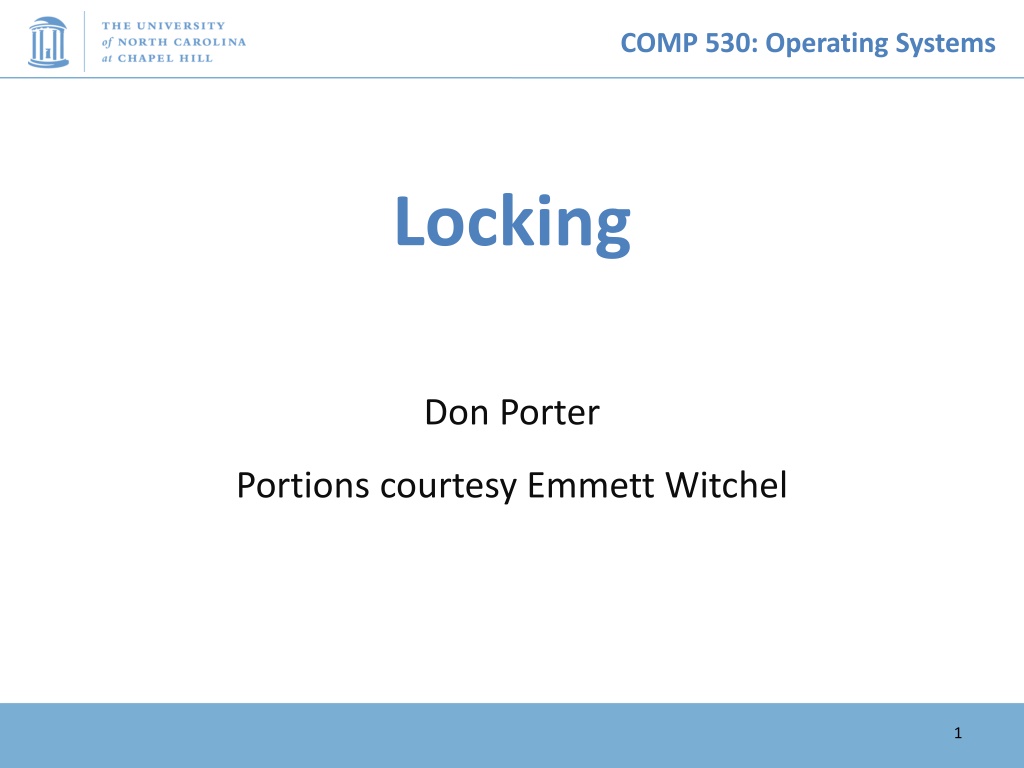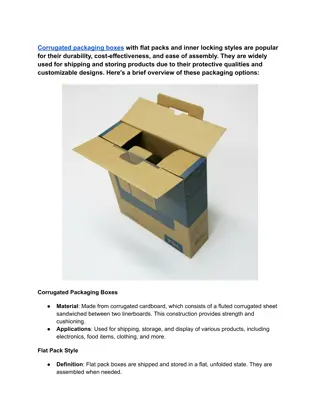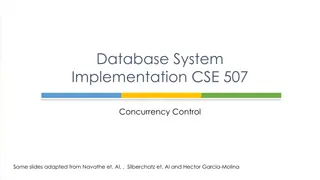Locking
This content delves into the complexities of operating systems, discussing issues related to locking mechanisms, concurrency problems, and the implementation of locks to ensure mutual exclusion. It explores various solutions such as hardware features utilization and higher-level programming abstractions to simplify concurrent programming. Additionally, it addresses issues with software solutions like Peterson's algorithm, highlighting the need for more efficient methods to handle multiple processes concurrently.
Uploaded on Feb 22, 2025 | 0 Views
Download Presentation

Please find below an Image/Link to download the presentation.
The content on the website is provided AS IS for your information and personal use only. It may not be sold, licensed, or shared on other websites without obtaining consent from the author.If you encounter any issues during the download, it is possible that the publisher has removed the file from their server.
You are allowed to download the files provided on this website for personal or commercial use, subject to the condition that they are used lawfully. All files are the property of their respective owners.
The content on the website is provided AS IS for your information and personal use only. It may not be sold, licensed, or shared on other websites without obtaining consent from the author.
E N D
Presentation Transcript
COMP 530: Operating Systems Locking Don Porter Portions courtesy Emmett Witchel 1
COMP 530: Operating Systems Too Much Milk: Lessons Software solution (Peterson s algorithm) works, but it is unsatisfactory Solution is complicated; proving correctness is tricky even for the simple example While thread is waiting, it is consuming CPU time Asymmetric solution exists for 2 processes. How can we do better? Use hardware features to eliminate busy waiting Define higher-level programming abstractions to simplify concurrent programming
COMP 530: Operating Systems Concurrency Quiz If two threads execute this program concurrently, how many different final values of X are there? Initially, X == 0. Thread 1 Thread 2 void increment() { int temp = X; temp = temp + 1; X = temp; } void increment() { int temp = X; temp = temp + 1; X = temp; } Answer: A. B. C. D. 0 1 2 More than 2
COMP 530: Operating Systems Schedules and Interleavings Model of concurrent execution Interleave statements from each thread into a single thread If any interleaving yields incorrect results, some synchronization is needed Thread 2 Thread 1 tmp1 = X; tmp2 = X; tmp2 = tmp2 + 1; tmp1 = tmp1 + 1; X = tmp1; X = tmp2; tmp2 = X; tmp2 = tmp2 + 1; X = tmp2; tmp1 = X; tmp1 = tmp1 + 1; X = tmp1; If X==0 initially, X == 1 at the end. WRONG result!
COMP 530: Operating Systems Locks fix this with Mutual Exclusion void increment() { pthread_mutex_lock(&lock); int temp = X; temp = temp + 1; X = temp; pthread_mutex_unlock(&lock); } Key abstraction: mutual exclusion while lock is held Goal: Protect unsafe code from dangerous interleavings At some loss of concurrency
COMP 530: Operating Systems Introducing Locks Locks implement mutual exclusion Two methods pthread_mutex_lock(lock) wait until lock is free, then grab it pthread_mutex_unlock(lock) release the lock, waking up a waiter, if any With locks, too much milk problem is very easy! Check and update happen as one unit (exclusive access) Lock.Acquire(); if (noMilk) { buy milk; } Lock.Release(); Lock.Acquire(); x++; Lock.Release(); How can we implement locks?
COMP 530: Operating Systems Performance: Between rock and hard place We need threads for concurrent performance We can t safely execute all code concurrently Locks ensure that delicate code does not interleave with other code that could interleave unsafely It is safe to execute everything in one big lock But worse performance than a single thread No concurrency + overheads Goal: get just enough mutual exclusion for safety, but no more than strictly necessary 7
COMP 530: Operating Systems How do locks work? Two key ingredients: A hardware-provided atomic instruction Determines who wins under contention A waiting strategy for the loser(s) 8
COMP 530: Operating Systems Atomic instructions A normal line of code (or CISC instruction) can span multiple memory operations Example: a = b + c requires 2 loads and a store These loads and stores can interleave with other CPUs memory accesses An atomic instruction guarantees that the entire operation is not interleaved with any other CPU x86: Certain instructions can have a lock prefix Intuition: This CPU locks all of memory Expensive! Not ever used automatically by a compiler; must be explicitly used by the programmer 9
COMP 530: Operating Systems Atomic instruction examples Atomic increment/decrement ( x++ or x--) int atomic_inc(int *var) { int rv = *var; *var++; return rv; } Used for reference counting, Returns old value that you specifically set If *var is 0, and 3 threads do an atomic_inc, one will get 1, one 2, and one 3 Atomic Test and Set: old = ts(&var) bool ts(int *) { bool ret = *int; *int = 1; return ret == 0;} Sets a value to 1 atomically; returns true if you were the thread that transitioned from 0 to 1 Compare and swap Common Syntax: cas(&var, old, new) {int rv = *var; if (*var == old) *var = new; return rv;} Used for many lock-free data structures 10
COMP 530: Operating Systems Atomic instructions + locks Most lock implementations have some sort of counter Say initialized to 1 To acquire the lock, use an atomic decrement Recall: atomic_dec returns the value your thread set If you set the value to 0, you win! Go ahead If you get < 0, you lose. Wait Atomic decrement ensures that only one CPU will decrement the value to zero To release, set the value back to 1 11
COMP 530: Operating Systems Waiting strategies Spinning: Just poll the atomic counter in a busy loop; when it becomes 1, try the atomic decrement again Blocking: Create a kernel wait queue and go to sleep, yielding the CPU to more useful work Winner is responsible to wake up losers (in addition to setting lock variable to 1) Create a kernel wait queue the same thing used to wait on I/O Reminder: Moving to a wait queue takes you out of the scheduler s run queue 12
COMP 530: Operating Systems Which strategy to use? Main consideration: Expected time waiting for the lock vs. time to do 2 context switches If the lock will be held a long time (like while waiting for disk I/O), blocking makes sense If the lock is only held momentarily, spinning makes sense Other, subtle considerations we will discuss later 13
COMP 530: Operating Systems Reminder: Correctness Conditions Safety Only one thread in the critical region Liveness Some thread that enters the entry section eventually enters the critical region Even if other thread takes forever in non-critical region Bounded waiting A thread that enters the entry section enters the critical section within some bounded number of operations. Failure atomicity It is OK for a thread to die in the critical region Many techniques do not provide failure atomicity
COMP 530: Operating Systems Example: Linux spinlock (simplified) 1: lock; decb slp->slock jns 3f 2: pause // Locked decrement of lock var // Jump if not set (result is zero) to 3 // Low power instruction, wakes on // coherence event // Read the lock value, compare to zero cmpb $0,slp->slock jle 2b jmp 1b 3: // If less than or equal (to zero), goto 2 // Else jump to 1 and try again // We win the lock 15
COMP 530: Operating Systems Rough C equivalent while (0 != atomic_dec(&lock->counter)) { do { // Pause the CPU until some coherence // traffic (a prerequisite for the counter // changing) saving power } } while (lock->counter <= 0); 16
COMP 530: Operating Systems Why 2 loops? Functionally, the outer loop is sufficient Problem: Attempts to write this variable invalidate it in all other caches If many CPUs are waiting on this lock, the cache line will bounce between CPUs that are polling its value This is VERY expensive and slows down EVERYTHING on the system The inner loop read-shares this cache line, allowing all polling in parallel This pattern called a Test&Test&Set lock (vs. Test&Set) 17
COMP 530: Operating Systems Test & Set Lock // Has lock while (!atomic_dec(&lock->counter)) CPU 0 CPU 1 CPU 2 Write Back+Evict Cache Line atomic_dec atomic_dec Cache Cache 0x1000 Memory Bus 0x1000 RAM Cache Line ping-pongs back and forth 18
COMP 530: Operating Systems Test & Test & Set Lock // Has lock while (lock->counter <= 0)) Unlock by writing 1 CPU 0 CPU 1 CPU 2 read read Cache Cache 0x1000 Memory Bus 0x1000 RAM Line shared in read mode until unlocked 19
COMP 530: Operating Systems Why 2 loops? Functionally, the outer loop is sufficient Problem: Attempts to write this variable invalidate it in all other caches If many CPUs are waiting on this lock, the cache line will bounce between CPUs that are polling its value This is VERY expensive and slows down EVERYTHING on the system The inner loop read-shares this cache line, allowing all polling in parallel This pattern called a Test&Test&Set lock (vs. Test&Set) 20
COMP 530: Operating Systems Implementing Blocking Locks pthread_mutex_lock() { while (ts(lock) == 1) ; // spin } pthread_mutex_lock() { while (ts(q_lock) == 1) { Put TCB on wait queue for lock; } With busy-waiting Without busy-waiting, use a queue pthread_mutex_unlock() { *q_lock = 0; if (wait queue is not empty) { Move 1 (or all?) waiting threads to ready queue; } pthread_mutex_unlock() { *lock := 0; } Must only one thread be awakened? Is this code fair?
COMP 530: Operating Systems Reader/writer locks Simple optimization: If I am just reading, we can let other readers access the data at the same time Just no writers Writers require mutual exclusion 22
COMP 530: Operating Systems Best Practices for Lock Programming When you enter a critical region, check what may have changed while you were spinning Did Jill get milk while I was waiting on the lock? Always unlock any locks you acquire
COMP 530: Operating Systems Implementing Locks: Summary Locks are higher-level programming abstraction Mutual exclusion can be implemented using locks Lock implementations have 2 key ingredients: Hardware instruction: atomic read-modify-write Blocking mechanism Busy waiting, or Cheap Busy waiting important Block on a scheduler queue in the OS Locks are good for mutual exclusion but weak for coordination, e.g., producer/consumer patterns.
COMP 530: Operating Systems Why locking is also hard (Preview) Coarse-grain locks Simple to develop Easy to avoid deadlock Few data races Limited concurrency Fine-grain locks Greater concurrency Greater code complexity Potential deadlocks Not composable Potential data races Which lock to lock? // WITH FINE-GRAIN LOCKS void move(T s, T d, Obj key){ pthread_mutex_lock(s); pthread_mutex_lock(d); tmp = s.remove(key); d.insert(key, tmp); pthread_mutex_unlock(d); pthread_mutex_unlock(s); } Thread 0 Thread 1 move(a, b, key1); move(b, a, key2); DEADLOCK!























